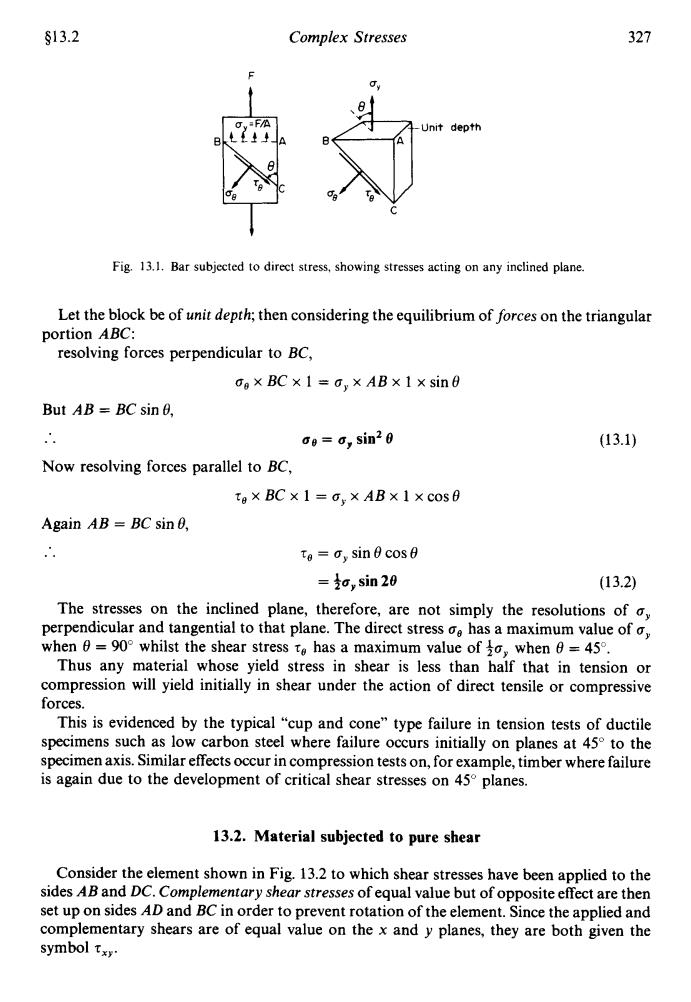正在加载图片...

§13.2 Complex Stresses 327 -Unit depth Fig.13.1.Bar subjected to direct stress,showing stresses acting on any inclined plane. Let the block be of unit depth;then considering the equilibrium of forces on the triangular portion ABC: resolving forces perpendicular to BC, og×BC×1=g,×AB×1×sin6 But AB BC sin 0, ae=a,sin20 (13.1) Now resolving forces parallel to BC, tg×BC×1=o,×AB×1Xcos6 Again AB BC sin 0. Te =y sin 0 cos0 =t,sin 20 (13.2) The stresses on the inclined plane,therefore,are not simply the resolutions of oy perpendicular and tangential to that plane.The direct stress has a maximum value of when6=90°whilst the shear stress te has a maximum value of to,whenθ=45°, Thus any material whose yield stress in shear is less than half that in tension or compression will yield initially in shear under the action of direct tensile or compressive forces. This is evidenced by the typical"cup and cone"type failure in tension tests of ductile specimens such as low carbon steel where failure occurs initially on planes at 45 to the specimen axis.Similar effects occur in compression tests on,for example,timber where failure is again due to the development of critical shear stresses on 45 planes. 13.2.Material subjected to pure shear Consider the element shown in Fig.13.2 to which shear stresses have been applied to the sides AB and DC.Complementary shear stresses of equal value but of opposite effect are then set up on sides AD and BC in order to prevent rotation of the element.Since the applied and complementary shears are of equal value on the x and y planes,they are both given the symbol tx$13.2 c Complex Stresses 327 t Fig. 13.1. Bar subjected to direct stress, showing stresses acting on any inclined plane. Let the block be of unit depth; then considering the equilibrium of forces on the triangular resolving forces perpendicular to BC, portion ABC: oo x BC x 1 = Q,, x AB x 1 x sin8 But AB = BC sin 8, .. bg = uy sin2 8 (13.1) Now resolving forces parallel to BC, T,x~cxi =o,,x~~xixcose Again AB = BC sin 8, .. to = sin 8 cos 8 = 30, sin 28 The stresses on the inclined plane, therefore, are not simply the resolutions of o, perpendicular and tangential to that plane. The direct stress uo has a maximum value of Q, when 8 = 90" whilst the shear stress q, has a maximum value of 30, when 8 = 45". Thus any material whose yield stress in shear is less than half that in tension or compression will yield initially in shear under the action of direct tensile or compressive forces. This is evidenced by the typical "cup and cone" type failure in tension tests of ductile specimens such as low carbon steel where failure occurs initially on planes at 45" to the specimen axis. Similar effects occur in compression tests on, for example, timber where failure is again due to the development of critical shear stresses on 45" planes. (1 3.2) 13.2. Material subjected to pure shear Consider the element shown in Fig. 13.2 to which shear stresses have been applied to the sides AB and DC. Complementary shear stresses of equal value but of opposite effect are then set up on sides AD and BC in order to prevent rotation of the element. Since the applied and complementary shears are of equal value on the x and y planes, they are both given the symbol rXy